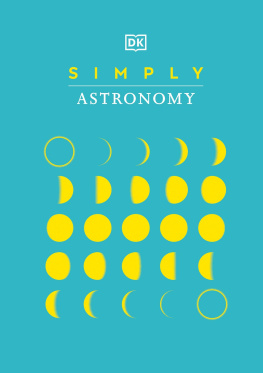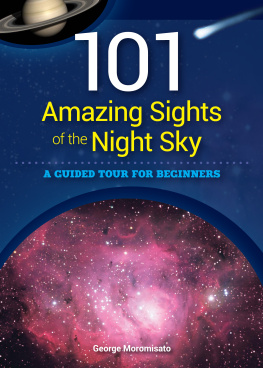
The Sky at Night
The Sky at Night
Easy Enjoyment from Your Backyard
Tim B. Hunter

The University of Arizona Press
www.uapress.arizona.edu
We respectfully acknowledge the University of Arizona is on the land and territories of Indigenous peoples. Today, Arizona is home to twenty-two federally recognized tribes, with Tucson being home to the Oodham and the Yaqui. Committed to diversity and inclusion, the University strives to build sustainable relationships with sovereign Native Nations and Indigenous communities through education offerings, partnerships, and community service.
2023 by The Arizona Board of Regents
All rights reserved. Published 2023
ISBN-13: 978-0-8165-4812-5 (paperback)
ISBN-13: 978-0-8165-4813-2 (ebook)
Cover design by Leigh McDonald
Cover photo by tengyart/Unsplash
Designed and typeset by Leigh McDonald in Adobe Caslon Pro 10.5/14, Millimetre by Jrmy Landes (Velvetyne Type Foundry) and Interstate (display)
Unless otherwise noted, all images are the authors.
Content of this book is based on Tim Hunters Sky Spy columns, published in the Arizona Daily Star beginning in 2007.
Library of Congress Cataloging-in-Publication Data
Names: Hunter, Tim B., author.
Title: The sky at night : easy enjoyment from your backyard / Tim B. Hunter.
Description: Tucson : University of Arizona Press, 2023. | Includes bibliographical references and index.
Identifiers: LCCN 2022015966 (print) | LCCN 2022015967 (ebook) | ISBN 9780816548125 (paperback) | ISBN 9780816548132 (ebook)
Subjects: LCSH: Amateur astronomy. | AstronomyPopular works. | AstronomyObservers manuals.
Classification: LCC QB44.3 .H86 2023 (print) | LCC QB44.3 (ebook) | DDC 520dc23/eng20220901
LC record available at https://lccn.loc.gov/2022015966
LC ebook record available at https://lccn.loc.gov/2022015967
Printed in the United States of America
This paper meets the requirements of ANSI/NISO Z39.48-1992 (Permanence of Paper).
This book is dedicated to my dear wife, Carol, who allows me to let my hobby of amateur astronomy run amok. It is also dedicated to my grandchildren Braeden Chhatpar and Amelia Chhatpar. May they come to love the sky as much as I do and remember me fondly someday when they are looking at Orion the Hunter, Scorpius the Scorpion, or a crescent Moon nearby ever-brilliant Venus.
Contents
Preface
I have been an amateur astronomer since 1950 when Miss Wilmore, my first-grade teacher, showed me a book of the constellations. I was fascinated by a drawing of Cygnus the Swan and wondered whether I could ever see that in the sky. As the years passed, my interest in astronomy grew. I got a Criterion four-inch Dynascope reflecting telescope when I was in eighth grade. I had saved up $50 from mowing lawns. My father helped me set it up, and I used it for many years off and on through high school, college, and medical school. In 1970, while I was serving in Vietnam, my parents gave my Dynascope to a boy down the street thinking I no longer wanted it or would use it. I often wonder what happened to that telescope and the boy.
My astronomy interest was always there, though I did not want to become a professional astronomer. I wanted to become a physician like my paternal grandfather, who was a pathologist. I graduated from Northwestern Medical School in 1968 and eventually became a radiologist after finishing my radiology training in 1974 at the University of Michigan in Ann Arbor.
Through all of this my interest in astronomy never went away, though it was somewhat on hold and only blossomed again when I moved to Tucson, Arizona, in January 1975 to become a faculty member of the Department of Radiology at the University of Arizona. Tucson likes to claim it is the Astronomy Capital of the World, and I agree. I joined the Tucson Amateur Astronomy Association, Inc. (TAAA) and became very active observing the sky, trying astrophotography, and attending local and national astronomical meetings and events.
Even though medicine was a wonderful career, I wondered whether I should have tried to become a professional astronomer or maybe even an astronaut. In the summer of 1976, I met Frank, a graduate student completing a PhD in engineering. He had a masters degree in astronomy from the University of Chicago, and I asked him why he switched to engineering from astronomy. Frank told me there were few jobs in professional astronomy, and he realized it was best to enjoy astronomy as an avocation rather than as a vocation. This got me thinking. I realized I was much better off enjoying astronomy as a hobby rather than as a vocation. I would have been no good as a professional astronomer, certainly not good enough to win a lot of grants or observing time on large professional telescopes. I had the best of all worlds: a great, satisfying career, and an ever-challenging and enjoyable hobby.
In January 2007, I received a call from Inger Sandal, editor of Caliente, the Thursday insert in the Arizona Daily Star that tells the public what to do about town, where to dine, what shows to see, and what adventures out of town to anticipate. She wanted to know if I would be interested in writing the Sky Spy column for each weekly edition of Caliente. This column had been started more than twenty years previously by Michael Smith, MD, a highly respected neurologist and amateur astronomer. I had known Mike for many years through our membership in the TAAA, as well as from his training at University Medical Center, the academic hospital for the College of Medicine at the University of Arizona.
Mike started Sky Spy on his own initiative, writing to the editor of the Arizona Daily Star and suggesting an astronomy column for the public. I dont know if he came up with the name Sky Spy, but he wrote a splendid column for nineteen years. I read it faithfully every week when it came out. After Mike, the column was continued by one of the papers reporters, who did a very fine job with it for seven years until he left the Arizona Daily Star to become the food editor of the rival newspaper, the Tucson Citizen.
Inger Sandal, the editor of Caliente, was in immediate need of a writer for the column when she called me. I certainly was not on anyones horizon as a noted astronomy columnist. Inger first asked David Levy, the popular author and comet discoverer, if he would like to write the column. He declined because he had his own column Star Trails in Sky and Telescope magazine, as well as many other ongoing writing projects and commitments. David is a very dear friend of mine and he suggested Inger call me.
I was certainly intrigued by Ingers offer, but I didnt know if I was up to the job. She kindly provided me with several recent Sky Spy columns to give me a perspective on what they contained and what she wanted. Then, I worked furiously that afternoon, stealing a bit of university time for my outside interest, writing a couple of sample columns that I sent to her. She liked them and suggested we proceed. On February 1, 2007, my first Sky Spy column was published.
Initially, the column was three hundred words and contained an illustration that I drew digitally using Photoshop and various digital star atlases. My illustrations were designed to show what the observer would see when looking in one direction or another. Sometimes, I submitted a photograph with the column. I fancy myself an astrophotographer, and a few of my astrophotographs were wide-field night sky images that would complement a particular column. Fortunately, Inger accepted almost all of my photographs, so I had a good place to publish some of my images that otherwise would not have found a home for publication.
Next page












